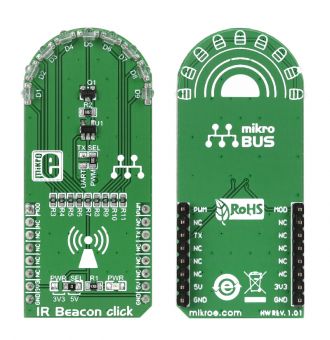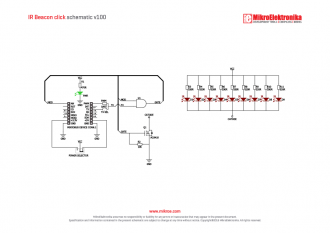
We strongly encourage users to use Package manager for sharing their code on Libstock website, because it boosts your efficiency and leaves the end user with no room for error. [more info]

Rating:
Author: MIKROE
Last Updated: 2019-03-15
Package Version: 1.0.0.1
mikroSDK Library: 1.0.0.0
Category: Optical
Downloaded: 5340 times
Not followed.
License: MIT license
IR Beacon click is a mikroBUS add-on board with an array of nine high speed infrared emitting diodes. It functions as a beacon device, transmitting infrared rays in a wide angle, which can be detected by nearby infrared receivers (such as the one on IR click).
Do you want to subscribe in order to receive notifications regarding "IR Beacon click" changes.
Do you want to unsubscribe in order to stop receiving notifications regarding "IR Beacon click" changes.
Do you want to report abuse regarding "IR Beacon click".

Library Description
The library covers all the necessary functions to control IR Beacon Click board.
IR Beacon Click communicates with the target board via PWM module.
This library contains drivers for enabling or disabling PWM and for enabling, disabling or reseting MOD.
Key functions:
void irbeacon_enableMod();- Function enables the device by seting MOD pin.Examples description
The application is composed of three sections:
void applicationTask()
{
irbeacon_enableMod();
for ( dutyCycle = 250; dutyCycle < 3000; dutyCycle += 250 )
{
irbeacon_pwmSetDuty( dutyCycle );
Delay_ms( 500 );
}
irbeacon_disableMod();
Delay_ms( 1000 );
}
Other mikroE Libraries used in the example:
PWMAdditional notes and informations
Depending on the development board you are using, you may need USB UART click, USB UART 2 click or RS232 click to connect to your PC, for development systems with no UART to USB interface available on the board. The terminal available in all MikroElektronika compilers, or any other terminal application of your choice, can be used to read the message
